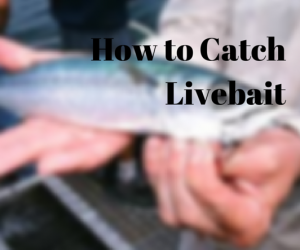I recently had a block on what to write about, so I put up a post on Facebook explaining this and asked fans of the Ocean Angler Facebook page what they wanted to know about. Quite a few requests came back on how and where to catch live baits.
Live baits would have to be the best way to catch trophy size fish, in my opinion. I used to fish a lot of snapper competitions and the first part of the contest always involved anchoring up and filling the live bait tanks with live baits; these were our number one way to catch big snapper, either drifting deep baits or starylining in the shallows. It was a really important part to our success.

Fish can become very wary of lures, and often, the case will be the smaller fish taking the lures or cutting bait and the big boys will not. When this happens, live bait can sometimes trigger the bigger fish into biting. Same with Marlin, sometimes they need live bait to be put in front of their nose to trick them into taking the bait. So as you can see here, it seems the older and wiser fish can be more susceptible to live baits over lures. This is not always the case though, but I do recommend having a source of wiggly live baits, if you are fishing any type of contest or targeting trophy sized fish.
We have many fish available in our waters that are ideal live bait. The most popular types being Yellowtail, Kahawai, Slimey Mackerel, Blue Koheru, and Piper. I will run through this list talking about the best way to catch them and a few clues of where you might find them.
Yellowtail
Rating for Snapper: 7/10
Rating for Kingfish: 7/10
They are a robust type of live bait that work well for both Snapper and Kingfish. These would have to be the most common type of live bait available to us. They are found in many different environments and are quite easy to catch. They are also durable and seem to be able to survive well in a live bait tank and last well dangling on your hook.

When I am targeting these fish, I first need to decide what method I am going to use to catch them. The easiest way is to drift along with sabikis, so I start with this method first. Then if that fails, I will anchor up around some foul ground and get the burly out to attract the fish to the back of the boat.
For drifting, the first thing to do is rig up your rods, use light spinning rods (soft bait rods are ideal). Tie on a good quality set of sabikis, if you can find the small pink shrimp imitation type – they seem to work the best. Next, tie on a sinker – this is where a lot of people go wrong; use a decent size sinker here 2oz-3oz is usually best. I find lighter sinkers to be a bit of a pain; they seem to catch less fish and the sabikis rig gets tangled more often. I also reckon the extra weight helps hook the fish by creating a bit of resistance to set the hook when the fish bites.
I like to look for these types of fish in bays or out on the open areas with a bit of current. Depths from 10M to 20M seem to be about right. The two methods I use to find them are the sounder and birds. Birds are the best, so get out the binoculars and look for any terns or shear-waters as they are a dead give away to their location. If I can’t see any birds, I will search along contour lines on the GPS chart plotter and, in particular, I will spend more time searching around any squiggles along the contour line which tells you the bottom is irregular.
Often bait-fish will congregate around these types of areas. Make sure you have your sounder tuned right, as they can be harder to detect than larger fish especially if they are loosely grouped. Motor along slowly looking for any type of marks; usually the mid water marks are bait ish. Have you anglers ready to drop; when you see the sign, stop the boat by giving it a bit of reverse and have the anglers drop the sabikis over straight away – they do not need to wait for the boat to stop.
You may want to bomb the marks which means being quick. The technique I use is to drop the rig straight to the bottom, then jiggle it around a lot, slowly winding up at the same time. By doing this, I am trying to figure out what depth they are holding in the water column. Once I discover this, I will generally jiggle my lures around in that depth. If there is difficulty catching it, try putting a small slither of bait on. More recently, we have been putting a small blob of scent on the sabiki flies which also works well.
Experiment with different depths and your jiggle technique. You’re trying to imitate a school of tiny fish panicking to trigger the Yellowtail to bite. When one is hooked, I always like to keep the rig in the bite zone for 10-30 seconds to try and load up all the hooks with bait fish. Remember, you’re trying to get this task completed quickly so you can get on with the real fishing.
The next part can be a bit tricky and what we do is have a dedicated live bait dehooker person who does not fish. The angler winds the fish in, then lifts the fish on board. Do not put them on the deck, hold them up off the deck with the rod and grab the sinker on the bottom with the other hand, then position the baits over the live bait tank, and have the dehooker person come along and take the fish off the hooks for you. Be aware it is best if you do not touch the fish at all as they will last longer. The dehooker person should use a butter knife to slide down the trace of the rig to the hook, then latch on to the hook and twist and flick the fish off, and let it fall into the bait tank.
Job done, catch another one. Try and figure out how many baits you will need for the day if your catching heaps easily load up the tank. Be aware, however, there is only so much oxygen in the live bait tank so don’t overload it or the baits will die.
A live bait tank, with a pump that sucks in water and discharges overboard, work much better than the aerated types. If this method does not work, try anchoring in a bit of current nested to some structure and use the same rigs with less weight to catch them in the burly trail. This method is more time consuming which is why it’s my second choice.
Kahawai
Snapper bait: 6/10
Kingfish bait: 8/10
Another robust type of bait that are easy to catch. The usual problem here can be catching the smaller ones if you’re going for Snapper. So I don’t really target these fish for Snapper live baits. However if I am going for Kingfish in particular, try slow trolling for them – they are very good. Bridle rig them and slow troll them in areas where there is a Kingfish; these are Kingfish candy.

To me, the best way to catch smaller Kahawai is to use a planer board and a small silver spoon or a salt-water fly. If you can find birds, start trolling around the birds that are feeding. If you can’t find any birds, troll around coastlines and points of water 8-12M in close proximity to rocks and seaweed. Planer boards are the best trick to catching these fish in the smaller sizes.
Slimy Mackerel
Snapper bait: 9/10
Kingfish bait: 8/10
These fish make awesome live baits. The reason being is that they are super oily and they create a lot of commotion as live baits. They don’t last as long as Yellowtail or Kahawai, but they spend a lot of energy panicking and zooming around on the hook.

Often, these fish will trigger shy fish into biting. Snapper love these fish. Drifting them in the deep water in Snapper territory gives you great chances of catching the bigger fish.
They can be harder to locate and I find most of them in waters 20M to 40M deep. You can often find them in wide open areas over sand in large schools. The two best methods are drifting with sabikis and trolling small silver spoons behind planer boards.
These fish need to be handled with care; look after them and they will help you catch bigger fish. They also make great dead baits because they are full of oil and blood; this is the reason they are one of my favourite live baits.
Blue Koheru
Kingfish bait: 10/10
Snapper bait: 10/10
The numbers say it all for this bait – my number one live bait. They are an awesome live bait because they are durable, long lasting, and very active on a hook. They whiz around and become very nervous which makes them a very good live bait. They are strong, full of oil, and Snapper and Kingfish love them. If I was to pick one out of the bunch, it would be this fish.

I have caught many big Snapper on this type of live bait. Our favorite trick is to rig them on a single hook through the nose, then cut the tail off before casting them into a burly trail. It’s always exciting stuff doing this as they very rarely last very long and get eaten very quickly by XL Snapper and Kingfish.
Funny thing is that they would be the hardest fish to catch as well. To catch these beauties, you usually need to be in remote or offshore reefs. They like to hang around foul ground with good current. The best way I have found to catch them is to anchor up next to an offshore island or reef in some current and burly back into the structure, and then use tiny jigs to catch them once they come around. Strong sabiki rigs will also work, but micro jigs seem to be the best way. They will come along and slam your jig so make sure it has a decent single hook on the jig so it does not bend. Single also makes it much easier to get the hook out of the fish’s mouth. Treble hooks on micro jigs should be removed to catch live baits; it makes life a lot easier. When you have hooked these fish, wind them up slowly and steadily as they come off the hook quite easily. They wriggle around a lot when you’re trying to put a hook through them, so it’s a good idea to use a wet towel or rag to hold on to them while you rig them up.
These fish also make excellent dead baits either used whole or as cut bait. My good trick with these fish is to cut a slice off their flank when they are dead which makes them bleed; sounds a bit cruel but it works very well for catching XL Snapper.
Piper
Kingfish bait: 10/10
Snapper bait: 8/10
These tasty fish are spectacular Kingfish bait and very good Snapper baits. The downside is that they are quite difficult to catch and they die quite easily on a hook. You need to look after these fish by giving them a good flow of water in the live bait tank, not touching them and using small hooks to rig them.

There is a real art to catching these fish, which makes it challenging and fun. The best areas seem to be sheltered bays out of the wind next to headlands and points with not much current flow. The best way is to anchor up and get a good burly flow going; try to use fine burly with not to many chunks in it. It can take a while to draw piper to the back of the boat; you need to be patient as they can be very shy.
I take catching these fish as quite a challenge; it’s really good fun. The best method I find is to get a set of sabikis and cut the string in half, so you have about 3 hooks. Then use the swivel that comes with the sabikis as the weight on the bottom of the rig. Next, use fine slivers of pilchard belly and hook them once through the sabiki hooks. Cast the rig out and let it sink for a few seconds and wind a bit very slowly. Then, let it fall to try and attract the Piper to the bait; they like it moving. When you see a Piper chasing the moving flies, stop winding and let it eat the bait. This is the moment where the skill comes in; you need to lift the rod at the right time to hook the piper in the corner of the mouth. If you strike too early, the hook will miss the corner of the piper’s mouth. If you wait too long, the piper will swallow the hook right down, which usually results in the fish bleeding and dying. Once you strike at the right time, very gently wind the fish in and lift it into the boat; then use the butter knife trick to release it into live bait tank.
When rigging these fish as live baits, I like to use small 2/0 live bait hooks and hook them in the tail just forward of the anal vent. Once they get tired, I then switch the hook to the front jaw and fish it until it dies. If you have a live bait kite, use it as they work very well for keeping the Piper alive.
Catching live baits can range from being very easy to very hard. As with all fish, some days they are on and other days they are off, assuming that there are not many days you cannot catch at least a few live baits and you only need one live bait to catch the winning fish in a contest.




Share:
Winter Strayline: The Key to Success
Gurnard fishing in the Manukau on Sunday, 12 July 2015